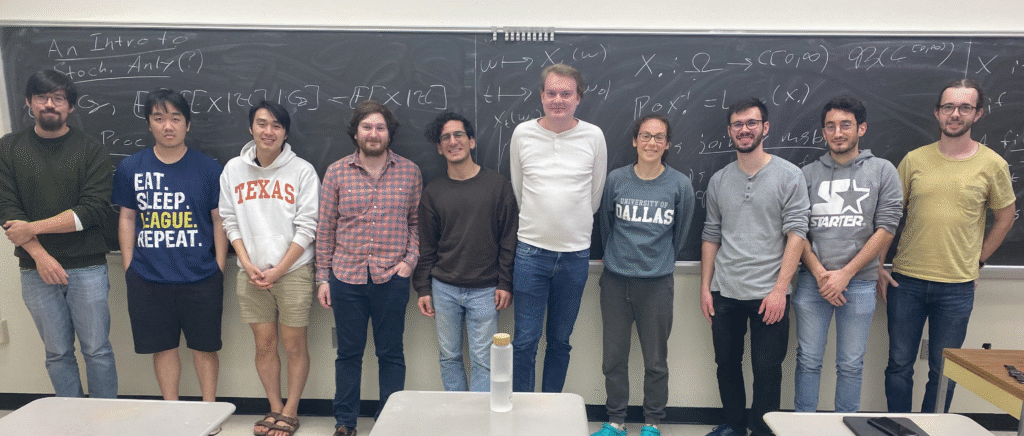
Organizer: Ken DeMason
January 29th: Zach Richey – An Intro to Stochastic Analysis, Part 1 of 2
Abstract
These two seminars will give an overview of the main topics in stochastic analysis, such as martingale theory, Brownian motion, and Ito calculus. The focus of the seminar will be presenting the important definitions, concepts, and the intuition behind them, rather than working through proofs in detail.
February 5th: Zach Richey – An Intro to Stochastic Analysis, Part 2 of 2
Abstract
This is part 2 of the talk last week.
February 12th: Esteban Cardenas – From weak to strong convergence in large fermionic systems
Abstract
In this talk I will give an overview of the main result of https://arxiv.org/abs/2312.03953. The minimizers of energy functionals in quantum mechanics are states that describe the configuration that the system reaches. In the macroscopic limit, these configurations can be described through an effective theory in the form of a convergence theorem. It had been proven that such convergence holds in a rather weak sense. We will show that it is possible to upgrade the mode of convergence to norm convergence, using physical information of the system (spoiler alert: the Pauli exclusion principle).
February 26th: Justin Toyota – Introduction to Tauberian Theorems
Abstract
A classical theorem of real analysis is Abel’s theorem, which states that if the sum of the coefficients of a power series converges, then the power series itself converges to the same sum when the variable approaches 1 from the left. Decades later, Alfred Tauber found a condition that allowed one to conclude the converse. As a result, theorems giving conditions under which summability in a weaker sense implies summability in a stronger one are known as Tauberian theorems. In this talk I will introduce some Tauberian theorems and the ideas used to prove them.
March 4th: Jeffrey Cheng – Viscous Destabilization of Shock Profiles for Scalar Conservation Laws
Abstract
We will discuss stability properties for viscous perturbations of scalar conservation laws. The recent theory of a-contraction with shifts gives stability results for the inviscid limit from viscous scalar conservation laws (VSCL) to scalar conservation laws (SCL) for small-amplitude shock profiles. In some sense, this shows that for small shocks, stability properties for the VSCL are very similar to those of the SCL. I will present results showing that for large-amplitude shocks, the situation is markedly different between the two.
March 18th: Will Golding – The Regularizing Effects of Grazing Collisions
Abstract
The homogeneous Landau equation is one of the fundamental models for collisional plasmas. In this talk, I will review some properties of the equation and show how grazing collisions lead to regularizing effects for solutions. Because the equation is highly nonlinear, these estimates are necessary to construct solutions.
March 25th: Zach Lee – On Uniqueness Properties of Solutions of the Generalized Fourth-Order Schrödinger Equations
Abstract
In this paper, we study uniqueness properties of solutions to the generalized fourth-order Schrödinger equations in any dimension of the following forms,$$i\partial_tu + \sum_{j=1}^d\partial_{x_j}^4=V(x,t)u$$ and $$i\partial_t u + \sum_{j=1}^d\partial_{x_j}^4u=F(u,\bar{u}).$$ We show that a linear solution u with fast enough decay in certain Sobolev spaces at two different times has to be trivial. Consequently, if the difference between two nonlinear solutions $u_1$ and $u_2$ decays sufficiently fast at two different times, it implies that $u_1 \equiv u_2$.
April 1st: Cooper Faile – Existence to solutions to conservation laws via the kinetic formulation
Abstract
I will present some results from the paper Lions, Perthame, and Tadmor “Kinetic Formulation of Conservation laws” (JAMS 1994.) This will lead to a theory different from what I presented last semester which was heavily based on BV estimates and gave existence for initial data with small total variation.
April 15th: Luisa Velasco – An introduction to Wave Turbulence and the Wave Kinetic Equation
Abstract
As the analog to the Boltzmann equation for a classical system of interacting particles, the wave kinetic equation (WKE) arises as an effective equation from microscopic systems of interacting waves. We will (hopefully) develop some intuition for turbulent systems, define quantities of interest, and sketch a formal derivation of the WKE.
April 22nd: Ken DeMason – On Isoperimetric Inequalities
Abstract
The isoperimetric inequality is a classical inequality first proven heuristically by Steiner using symmetrization. We’ll showcase this technique, as well as two others borrowing ideas from Optimal Transport and the ABP method, to prove the isoperimetric inequality and its rigidity case.